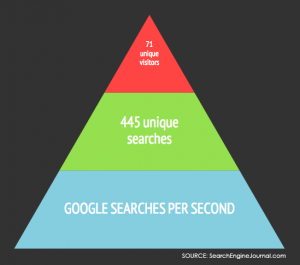Less is More: The Content Battle
 Like many advertising and public relations firms, we are in the website business. We were one of the first agencies on the Mississippi Gulf Coast to have a complete in-house production team; and in the early years, it served as the foundation of our business. During that time (and now), we’ve seen a lot of website trends come and go; but one that seems to be a Stage 5 Clinger is the trend of “More pages. Better Google rankings.” Because there’s a strong emphasis on being ranked at the top of Google’s search results, tricky Internet marketing people continue to push others to believe that this is true.
Like many advertising and public relations firms, we are in the website business. We were one of the first agencies on the Mississippi Gulf Coast to have a complete in-house production team; and in the early years, it served as the foundation of our business. During that time (and now), we’ve seen a lot of website trends come and go; but one that seems to be a Stage 5 Clinger is the trend of “More pages. Better Google rankings.” Because there’s a strong emphasis on being ranked at the top of Google’s search results, tricky Internet marketing people continue to push others to believe that this is true.
But guess what? It’s not true. Not even a smidgen.
As a child, my dad always said two things “Nothing in life is free” and “If it seems too good to be true – it usually is.” Both of these idioms apply to this situation. Before we go too much further…
If you’ve had a sales rep call you and tell you how he or she can change your website for the better in a matter of minutes, without spending much money AND have you rank above the fold on page one – please tell them you are not interested.
Here’s why:
The world of online search continues to evolve, and because of those tricky Internet marketing people who are trying to sell their version of the gospel to make a quick dollar – Google has to stay 12 steps ahead. This means the search algorithm that determines what gets seen – when and where – is always a work in progress. Remember – Google is on the user’s side, doing whatever it can to provide high quality content, as quickly and convenient as possible (a good example of that is this week’s mobile algorithm change). We believe that content is WAY more than just words on a website. It’s a way to connect the audience to the organization, a way to provide value – and a way to do and be more. We talk to a lot of clients who are simply worried about SEO and where their website ranks (rightfully so), and it’s our practice to make sure that the content written for their site will do such, but not compromise the integrity of the site itself or the brand as a whole.
Here’s how we do that:
 1. Create content worth reading.
1. Create content worth reading.
Every second, approximately 445 unique searches are entered into Google by 71 unique visitors. PER SECOND! Think about what you do in the scope of searching for something. You probably browse the top three to five links, and modify your search terms if you don’t find what you want in a matter of seconds. With that in mind, we create content for clients based on a middle of the road compromise (for user and for the client). We position information in a way that provides value to the client and end-user, quickly and easily. Using a hierarchy of the most important information allows us to tailor the content exclusively to the user and client’s needs. Some people call it science… we call it being human.
2. Understanding end-user needs.
Think about your own web browsing habits. How often do you enjoy clicking ten pages deep to find the information you want? I will go out on a limb and say that you don’t, at all. And that you probably bounce from the site to find your information elsewhere. This is where the “more pages = more rankings” theory becomes an issue. Not only can Google tell when a page is stuffed with keywords and irrelevant content – it also knows when pages replicate information. Google will automatically mark these sites with lower rankings. Good, informative content, that is easy to navigate will always be more helpful to the end-user – thus it will always rate higher with Google.
3. Meet web design and programming standards.
On Tuesday, Thomas mentioned the Google algorithm change regarding mobile. Being aware of algorithm changes, how users navigate websites and what that means in terms of design, code and content are things we keep at the forefront of our processes. They work together to create a good user experience. If you have rockstar content, but the navigation to get there breaks down the path for the user – it renders it pointless. If a tree falls in the woods, and no one was there to hear it – did it fall? Fun Fact: The rule of thumb for re-evaluating your website design and programming is about 3 years. We stay on top of industry trends so that we can help clients maintain a site that is keeping the eyes of users, and still meeting best practices for search engine optimization.
So… less really is more. As cliche’ as it sounds – it’s the truth. If you feel a bit lost in regards to your website and what you need to do next – give us a call! This is what we do. It’s what we are proud of and we would be more than happy to help!
Samantha McCain
PR & Content Manager
